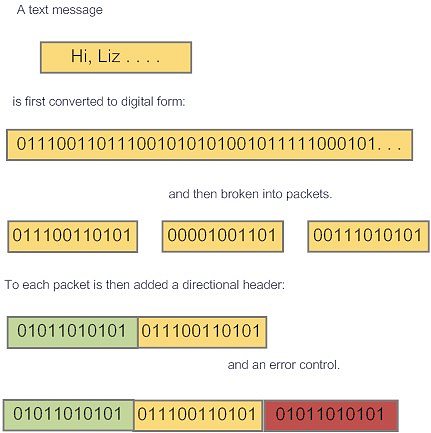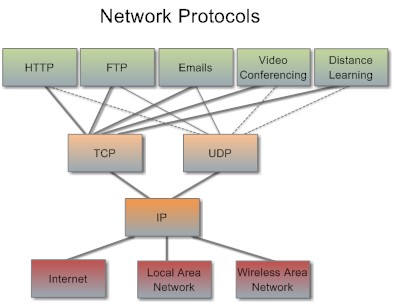 Section
Navigation
Section
Navigation
7. Technical Aspects
:Fundamental
7.1 Anatomy of Internet
7.2 Telecommunications
7.3 Wireless systems
7.4 Client Computers
7.5 Mobile Devices
7.6 Operating Systems
7.7 Computer Programs
7.8 Security: Applications
7.9 Browsers
7.10 Business Intelligence Systems
7.11 Cloud Computing
7.12 Databases
7.13 DTP Programs
7.14 eBook Readers
7.15 eMail Services
7.16 Expert Systems
7.17 Graphics Programs
7.18 Internet TV
7.19 Music & Video
7.20 Really Simple Syndication
7.21 Rich Media
7.22 Search Engines
7.23 Spreadsheets
7.24 Video Conferencing
7.25 Word Processing
:Corporate Matters
7.26 Cluster Analysis
7.27 Neural Networks
7.28 Pricing Models
7.29 Realtime Systems
7.30 Regression Analysis
 7.2
Telecommunications
7.2
Telecommunications
Telecommunications is an important, expanding and highly technical field,
{11} {12} {17} {18} but a grasp of the basics will help make sense of
other topics in this technical section.
Analog and Digital
Any telecommunication system has three units:
1. A transmitter that takes information and converts it to a signal.
2. A physical channel (cable) or transmission medium (wireless/satellite)
that carries the signal.
3. A receiver that takes the signal and converts it back into usable
information.
The signal itself can be of two types:
1. Analog, where information is provided by a continuously varied signal
(e.g. a waveform representing the strength and pitch of a human voice).
2. Digital, where information is encoded as a set of discrete values
(e.g. a series of ones and zeros).
Digital systems are generally preferred, because there is:
1. Less noise: the signal is not so degraded by transmission imperfections.
2. More reliability: signals can be encoded with checksums to ensure
parts are not lost.
3. Greater efficiency: digital systems can be compressed.
4. Increased security: digital signals can be encrypted.
5. Better use of resources: packet switching allows data to be sent
by optimal routes.
Packet Switching

Packet switching is used many Internet applications, including the World Wide Web, email, File Transfer Protocol, Secure Shell, peer-to-peer file sharing, and some streaming media applications (of which more later). Protocols are sets of rules that govern data communication on networks, i.e. fundamental, device-independent software instructions that enable signals to flow and interact in an orderly fashion.
Two such protocols, IP and TCP, make the Internet possible. The Internet Protocol (IP) slices the digital signal into packets, and then adds a header identifying destination of the packet (and, optionally, the routers to be used) plus an error control. There are several IP versions, and the more flexible version 6 (IPv6) is only slowly replacing version four (IPv4).
Network Protocols
Network congestion, traffic load balancing, or other unpredictable network behaviors can cause IP packets to be lost, duplicated, or delivered out of order. A further protocol is therefore added: TCP. Transmission Control Protocol detects these problems, requests retransmission of lost data, rearranges out-of-order data, and even helps minimize network congestion to reduce the occurrence of the other problems. Once the TCP receiver has reassembled the digital packets as originally intended, it passes them to the application program.

TCP needs a fixed connection. If one application wants to communicate with another via TCP, it sends a communication request to an exact address. After a "handshake" between the two applications, TCP will set up a two way communication between applications, continuing until this is closed by one of the applications. In contrast, IP does not need a fixed connection, but takes advantage of whatever network routes are open at the time.
Because optimal routes are continually changing, a signal of any length will be sent as several packets on different routes, the packets being guided by their headers and routers to their intended destination, where they are reassembled by TCP. Because they operate largely independently of each other, protocols are often viewed as distinct layers. At base, as in the diagram above, there lies the network of computers and connections that physically makes up the Internet. Then come two layers of protocols, IP and TCP (sometimes with the faster but less accurate UDP: User Datagram Protocol) which together work on any physical system and link up with all applications. In the top layer appear the applications themselves, which are specific to the operating systems run by the user's computer: Mackintosh, Windows or Linux.
Computers link to the Internet through software that understands and interprets the TCP/IP protocols. The software is known as a socket or a TCP/IP stack, and is built into the computer's operating system. For PCs, the software is called Winsock. For Macs, the software is called MacTCP. If the link to the Internet is through a LAN (local area network), cable modem, or DSL line, a computer needs a network card or equivalent, with the software to run it. If the link is through a modem, the computer must use one of two software protocols, either Serial Line Internet Protocol (SLIP) or Point-to-Point Protocol (PPP), both of which hook up with the Internet's TCP/IP protocols.
The Internet operates on the client/server model of information delivery. The client is typically the local personal computer or its associated software. The server (also known as the host) is generally a more powerful computer that houses the data and/or server software. The client computer connects to a server computer, requests information, which the server looks for, assembles and sends to the client computer. Often the information is web pages, but it may also be database information, email and indeed a host of other service information. Hosts and clients can be of many makes and manufacturers, and run a wide variety of operating systems: the Internet protocols ensure data is transferred seamlessly.
Essential to the Internet is the Domain Name System (DNS), which provides client computers and servers with an address, called the uniform resource locator, or URL for short. The DNS translates the plain English address, www.mysite.com, into a series of numbers called an IP (Internet Protocol) address. An IP address, such as 123.23.45.121, marks the location of a computer on the Internet, and the mysite.com address is known as a domain. Common domain addresses include .com (commercial), .edu (education), .gov (government), .mil (military), .net (Internet service providers and networks) and .org organization). Powerful computers called name servers are responsible for keeping track of domains and translating them them to the IP addresses the Internet understands. Large companies generally have a static address, but client computers using an Internet Server Provider (ISP) are usually provided with a temporary or dynamic IP address, chosen from the limited number allocated to the ISP.
More on Channels
The account above is much simplified. In fact, to overcome the tendency of big companies like IBM and Novel to define their own protocols, the International Standards Organization developed a standard called OSI (Open System Interconnection), which defined seven different layers of protocols. Each layer was responsible for a different function, and was independent of the layers above and below. The seven layers, along with an added security layer, are:
1. Physical Layer, which covered the actual transmission medium (e.g.
radio waves) and governed the type of modulation used (amplitude, frequency,
or phase) and the design of interface plugs.
2. Data Link Layer, which covered the type of LAN architecture (usually
Ethernet) and the TDMA or CDMA multiplexing schemes of standards such
as GSM and cdmaOne in a wireless network.
3. Network Layer, which was responsible for actually transferring data
between different machines (commonly IP but included IBM's NetBui and
Novell's Internet Packet Exchange).
4. a. Transport Layer, which covered error control and prioritizing
traffic (TCP or UDP on the Internet, and Wireless Datagram Protocol
on mobile phone transmission), and b. Security Layer, which includes
various encryption systems (Secure Socket Layer on the Internet, and
Wireless Transport Layer on mobile phone transmissions).
5. Session Layer controlling who can send or receive information (in
fact occupied by SSL on the Internet, and split into an upper Wireless
Session Protocol and a lower Wireless Transaction Protocol for Wireless
Application Protocols, i.e. mobile phone transmission).
6. Presentation Layer which controlled how data was presented to applications,
but is rarely used.
7. Application Layer, which covered the protocols familiar to the public
(HTTP and FTP on the Internet, and Wireless Application Environment
with its various applications on WAP).
A web page request thus proceeds as follows:
Layer |
Computer |
Action |
Server |
|
|
Client |
Client decidesto visit companyweb page |
Company |
Application Layer |
www.client.com |
> Find companyIP address and thenreceive < DNS information |
DomainName Server |
Transport Layer |
www.client.com |
> Send HTTPrequest in packets > |
www.company.com |
Network Layer |
www.client.com |
> Send HTTP requestin packets(IP or other) > |
www.company.com |
Datalink Layer |
www.client.com |
> Send messagedivided into frameswith errorcorrection packets > |
www.company.com |
Physical Layer |
Client computer |
> modem > router >cable > coaxial cable > |
Company server |
Error Tracing
Engineers commonly check an Internet line by using such tools/commands as Ping, NSLookup, Tracert, etc. that test whether devices like routers, servers or switches are contactable. Ping {14} checks that a server, etc. is functioning, and measures the time taken by the transmission round-trip. Nslookup {15} finds name server information for domains by querying its DNS. Traceroute {16} shows the path (via routers) of a packet of information from your computer to one you specify.
 Questions
Questions
1. Explain the difference between analog and digital signals: why is
digital preferred?
2. Explain the principles of packet switching.
3. What are network protocols?. Give some protocols important to the
Internet, and explain what they do.
4. Outline the channels of the Open System Interconnection standard.
5. Explain how Ping and Tracert are used, and why.
 Sources and Further Reading
Sources and Further Reading
Telecommunications is a difficult subject, and many aspects will benefit from reading more technical literature than is listed here.
1. Telecommunications Essentials, Second Edition:
the Complete Global Source by Lillian Goleniewski and Kitty Wilson
Jarrett. Addison-Wesley Professional. 2006.
2. Networking and Telecommunications: Concepts, Methodologies, Tools
and Applications by Information Resources Management Association.
IGI Global. 2010.
3. Telecommunication. Wikipedia.
Introduction, covering most aspects in a non-technical manner.
4. Internet Protocol. Wikipedia.
Brief article touching on protocols complexities.
5. Transmission Control Protocol. Wikipedia
Provides much more detail than is summarized on this page.
6. Digital Wireless Basics. Privateline.
Good historical account, not technical until the end.
7. Basic Journey of a Packet. Symantec.
A simply-written account, but a basic understanding of computer processing
will help.
8. An Overview of TCP/IP Protocols and the Internet. Gary
Kessler. Update of paper originally submitted to the InterNIC.
9. Communications Satellite. Wikipedia.
General account, not limited to Internet technologies.
10. Histories of the Internet. Internet
History. Many accounts and useful links to Internet authorities.
11. Course Notes: Signals, Systems and Inference. MIT
Open Courseware. Spring 2010.
12. Computer Networking. Wiki
Openbooks. Technical and still in progress.
13. What is Ping? WhatIsPing.Net.
Simple introduction.
14. Nslookup by Bradley Mitchell. About.com.
How to instructions.
15. How to Use the Traceroute Command. Media
College. Commands and interpreting the results.
16. Network Tools. Access
to Ping, Lookup, Trace, URL decode, email verification.
17. Communication theory. Univ.
of Missouri. Course outline, indicating what is covered.
18. Wireless Networks & Security by Peter Dordal. Loyola
University Chicago. Fall 2008. Online course notes.